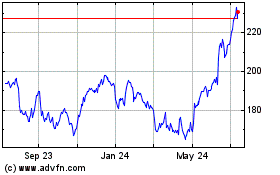Tech Bonds Outperform While Stocks Fall
April 02 2018 - 2:39PM
Dow Jones News
By Sam Goldfarb
Technology stocks fell again Monday, but the sector has fared
relatively well recently in the bond market -- a signal that there
has been more concern about the growth prospects of tech companies
than their fundamental credit quality.
The extra yield, or spread, that investors demand to hold
investment-grade tech bonds has increased 0.17 percentage point to
0.88 percentage point from its recent low on Feb. 2, according to
Bloomberg Barclays data. During that time, the spread on
investment-grade corporate bonds over U.S. Treasurys has climbed
0.24 percentage point to 1.09 percentage point.
By contrast, the S&P 500 information technology sector has
fallen roughly 6% over the past month -- a larger drop than the
4.5% decline of the overall S&P 500. After powering stock
indexes to records earlier this year, tech stocks have come under
pressure in recent weeks due partly to data-privacy concerns and
increased scrutiny from regulators and lawmakers.
Prices on tech bonds, for their part, have also fallen but only
modestly and, analysts say, largely for the simple reason that
benchmark interest-rates are rising.
FAANG companies -- Facebook Inc., Amazon.com Inc., Apple Inc.,
Netflix Inc. and Google parent Alphabet Inc. -- tell the same
story.
While Facebook doesn't have bonds, the spread on Amazon's 3.15%
notes due 2027 has increased by 0.20 percentage point since Feb. 2
to 0.85 percentage point, according to MarketAxess. Apple's 3%
bonds due 2027 have widened by 0.17 percentage point to 0.76
percentage point. And Alphabet's 1.998% bond due 2026 has climbed
0.15 percentage point to 0.50 percentage point.
As a junk-rated firm, Netflix is in a different category. But it
has also performed better than its peers. While the average
high-yield bond spread has increased 0.43 percentage point since
its recent low on Jan 26, the spread on Netflix's 5.875% notes due
2025 has climbed just 0.35 percentage point to 2.3 percentage
points.
The relative strength of technology bonds can be tied to two
major factors, said Jordan Chalfin, a senior analyst at the
research firm CreditSights.
"There's a lot of headline risk, mostly regulatory, that I think
could have implications for the upside on equities, but I don't
think anyone is questioning the sustainability of these
businesses," he said.
In addition, the recently passed tax overhaul has made it easier
for technology companies to repatriate foreign earnings, meaning
they no longer need to issue debt to fund shareholder-return
programs. A reduced supply of technology bonds should bolster
prices, Mr. Chalfin said.
Write to Sam Goldfarb at sam.goldfarb@wsj.com
(END) Dow Jones Newswires
April 02, 2018 14:24 ET (18:24 GMT)
Copyright (c) 2018 Dow Jones & Company, Inc.
Apple (NASDAQ:AAPL)
Historical Stock Chart
From Aug 2024 to Sep 2024

Apple (NASDAQ:AAPL)
Historical Stock Chart
From Sep 2023 to Sep 2024
